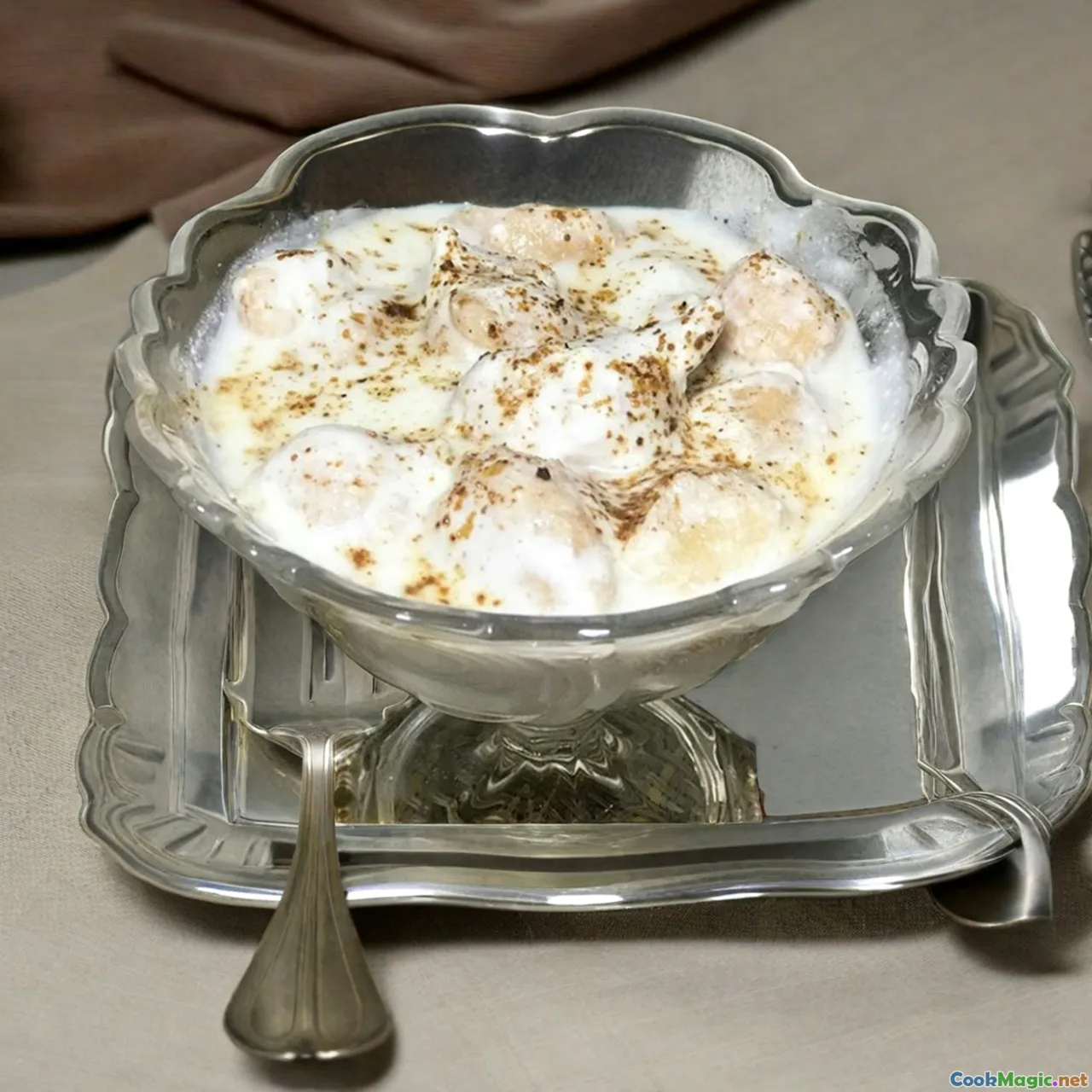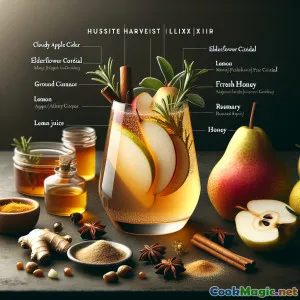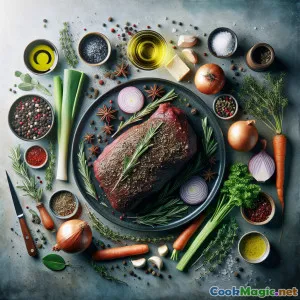
Copos de Creme de Seiva de Bétula & Cevada: Uma Delícia Britânica
(Birch Sap & Barley Cream Pots: An English Delight)
(0 Avaliações)0
1,210
julho 14, 2025
Reportar um problema
Ingredientes
-
60 grams Cevada perolada
(Enxaguado em água fria)
-
300 ml Leite integral
(Cozinhar cevada)
-
200 ml Seiva de bétula
(Fresca ou engarrafada; pode ser substituída por água de coco de sabor mais suave)
-
250 ml Creme de leite dupla
(Para riqueza e textura suave)
-
60 grams Açúcar fino
(Ajuste ao gosto dependendo da doçura da seiva de bétula)
-
3 large Gemas de ovo
(Em temperatura ambiente)
-
1 whole Baunilha
(Divida e raspe as sementes, ou use 1 colher de chá de pasta de baunilha)
-
1/4 tsp Sal marinho
(Realça o sabor)
-
2 tsp Mel
(Flor de campo inglesa, ideal para regar)
-
20 grams Avelãs Torradas
(Picado grosseiramente, para decorar)
(Enxaguado em água fria)
(Cozinhar cevada)
(Fresca ou engarrafada; pode ser substituída por água de coco de sabor mais suave)
(Para riqueza e textura suave)
(Ajuste ao gosto dependendo da doçura da seiva de bétula)
(Em temperatura ambiente)
(Divida e raspe as sementes, ou use 1 colher de chá de pasta de baunilha)
(Realça o sabor)
(Flor de campo inglesa, ideal para regar)
(Picado grosseiramente, para decorar)
Nutrição
- Porções: 4
- Tamanho da Porção: 1 ramequin (150ml)
- Calories: 350 kcal
- Carbohydrates: 33 g
- Protein: 7 g
- Fat: 21 g
- Fiber: 2.5 g
- Sugar: 13 g
- Sodium: 70 mg
- Cholesterol: 134 mg
- Calcium: 115 mg
- Iron: 1.2 mg
Instruções
-
1 - Cozinhar Cevada com Leite:
Enxágue a cevada perlada e adicione-a a uma panela pequena com leite integral. Leve a uma fervura suave e cozinhe, sem tampa, até que a cevada esteja bem macia, cerca de 25 minutos. Mexa regularmente para evitar que grude. Reserve e deixe esfriar levemente.
-
2 - Bater para Cremoso:
Despeje a cevada cozida e o leite restante em um liquidificador. Bata bem até que a mistura fique o mais lisa possível. Passe por uma peneira fina para remover qualquer casca de cevada restante, proporcionando uma textura mais suave.
-
3 - Infundir Seiva de Bétula e Creme:
Em uma panela limpa, combine o seiva de bétula, creme duplo, a mistura de cevada coada e as sementes da vagem de baunilha (se estiver usando). Aqueça suavemente, mexendo constantemente, até o ponto de vaporização, mas sem ferver.
-
4 - Preparar gemas de ovo e açúcar:
Enquanto isso, bata as gemas de ovo com açúcar de confeiteiro e sal marinho em uma tigela grande até ficarem mais claras na cor e levemente espessas.
-
5 - Temperar e Misturar:
Despeje lentamente cerca de um terço do creme de bétula-cevada quente na mistura de ovos enquanto mexe constantemente. Após temperar, misture a mistura de ovos de volta à panela com o restante do líquido quente.
-
6 - Cozinhar a Base de Creme de Ovo:
Em fogo baixo, mexa continuamente a mistura do creme até engrossar o suficiente para cobrir uma espátula (cerca de 82°C se usar um termômetro). Não deixe ferver.
-
7 - Resfrie em ramekins:
Divida em quatro ramekins de 150ml. Deixe esfriar até atingir a temperatura ambiente, cubra e leve à geladeira por pelo menos 2 horas até firmar suavemente.
-
8 - Decorar e Servir:
Para servir, regue um pouco de mel inglês por cima e espalhe com amêndoas de avelã torradas picadas, se desejar. Sirva frio e cremoso.
Enxágue a cevada perlada e adicione-a a uma panela pequena com leite integral. Leve a uma fervura suave e cozinhe, sem tampa, até que a cevada esteja bem macia, cerca de 25 minutos. Mexa regularmente para evitar que grude. Reserve e deixe esfriar levemente.
Despeje a cevada cozida e o leite restante em um liquidificador. Bata bem até que a mistura fique o mais lisa possível. Passe por uma peneira fina para remover qualquer casca de cevada restante, proporcionando uma textura mais suave.
Em uma panela limpa, combine o seiva de bétula, creme duplo, a mistura de cevada coada e as sementes da vagem de baunilha (se estiver usando). Aqueça suavemente, mexendo constantemente, até o ponto de vaporização, mas sem ferver.
Enquanto isso, bata as gemas de ovo com açúcar de confeiteiro e sal marinho em uma tigela grande até ficarem mais claras na cor e levemente espessas.
Despeje lentamente cerca de um terço do creme de bétula-cevada quente na mistura de ovos enquanto mexe constantemente. Após temperar, misture a mistura de ovos de volta à panela com o restante do líquido quente.
Em fogo baixo, mexa continuamente a mistura do creme até engrossar o suficiente para cobrir uma espátula (cerca de 82°C se usar um termômetro). Não deixe ferver.
Divida em quatro ramekins de 150ml. Deixe esfriar até atingir a temperatura ambiente, cubra e leve à geladeira por pelo menos 2 horas até firmar suavemente.
Para servir, regue um pouco de mel inglês por cima e espalhe com amêndoas de avelã torradas picadas, se desejar. Sirva frio e cremoso.
Mais sobre: Copos de Creme de Seiva de Bétula & Cevada: Uma Delícia Britânica
Birch Sap and Barley Cream Pots
Summary
This wholly original recipe for Birch Sap and Barley Cream Pots captures the gentle awakening of an English spring in a delicate, creamy dessert bowl. Combining the subtle, natural sweetness of birch sap with the nutty, old-world flavors of barley, and elevating it all with rich dairy and softly set custard, this dish blurs the lines between modern British innovation and age-old traditions. Its unassuming, creamy aesthetics hint at something more interesting upon first spoonful—an earthy complexity and layers of silky, gentle sweetness.
History and Cultural Significance
Birch sap, gathered from centuries-old woodland traditions, was once a celebrated ingredient in the Northern Hemisphere—tapped for just a few short weeks each spring. In the UK, though largely forgotten in mainstream cuisine, folklore remembers birch sap as a rejuvenating 'British tonic,' sometimes fermented into wine or mixed into healing concoctions. Barley’s role as a staple cereal can be traced from Neolithic times to roots in rustic British desserts and hearty stews, symbolizing resilience, comfort, and an affinity with the landscape.
Combining birch sap with barley in a creamy custard was inspired by traditional milk puddings and contemporary farmhouse desserts, but here given a new voice—bridging foraged, historic flavors and classic dessert typology.
Unique Aspects and Personal Notes
Birch Sap and Barley Cream Pots stand out not just for their writeup of “wild sophistication:”
-
The birch sap brings unique complexity, lightly floral, slightly sweet, unlike anything sugar or syrup could impart. Using birch sap as a base (where you might otherwise reach for milk, water, or coconut water) coaxes out woodsy, sappy nuances and gently perfumes the dessert.
-
Barley lends nutty undertones and provides a textural base for the custard when rendered ultra-smooth. It bulks the cream without heaviness, forming the bridge between tradition and elegance.
-
The slow, low cook and careful tempering of egg yolks ensure an unctuous, gentle set—not quite a thick jelly, more opulent than most milk puddings, yet firmer than classic pouring custard.
-
Lightly sweetened, with a dash of honey to serve, it needs little embellishment: a contrast of roughly chopped hazelnuts highlights the woodland origins and counters the creaminess, while a use of vanilla is purely optional—leaning into (or away from) the pure birch-milk aroma as you wish.
Tips & Notes
- Sourcing birch sap can be the main barrier; look for it bottled online or at specialty food stores during spring. If unavailable, slightly diluted maple water or even coconut water makes a gentle and neutral substitute, though each lacks pure birch nuance.
- The barley cream achieves true silkiness by thorough blending and straining—don’t rush this part.
- If desired, infuse other seasonal wild herbs (like meadowsweet or elderflower) into the cream just before straining, amplifying the wild character of the dessert.
- Keeping the yolk-cream mixture below boiling (82°C/180°F) prevents curdling, giving that opulent texture prized in classic pots de crème.
- These set softly for an impressive table finish but keep hands-off when cooling; the chilling step is essential to their success.
Variations and Serving
You may experiment with nut toppings—try toasted pecans or almonds. Birch syrup (used with restraint) works as a garnish for darker caramel bitterness, or swap in seasonal berries and a little buttermilk for a tart contrast. Best served foraged-ingredient dinners, a woodland afternoon tea, or simply to evoke lush English meadows wherever you are. If serving to guests, the story of birch sap’s scarcity and tradition could become the star conversation.
This unique dessert pot manages to be both subtly wild and beautifully refined—an unmistakable taste of the British landscape, reimagined for today’s palate.
























